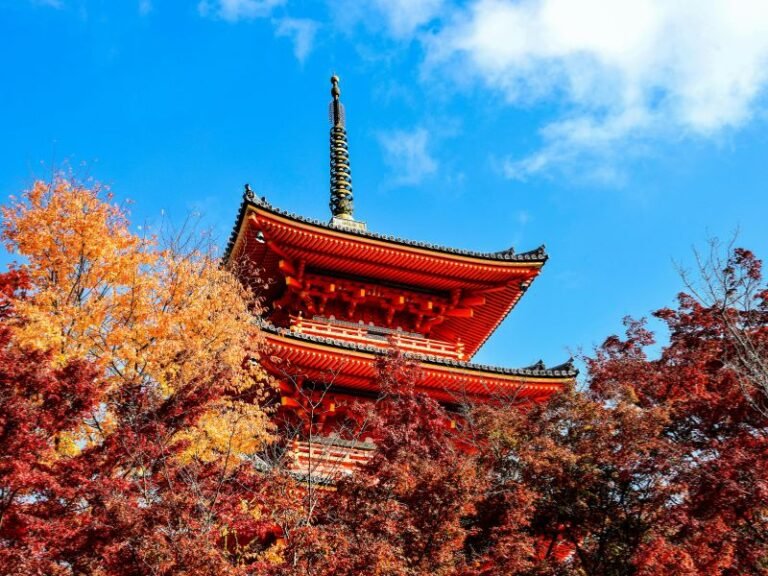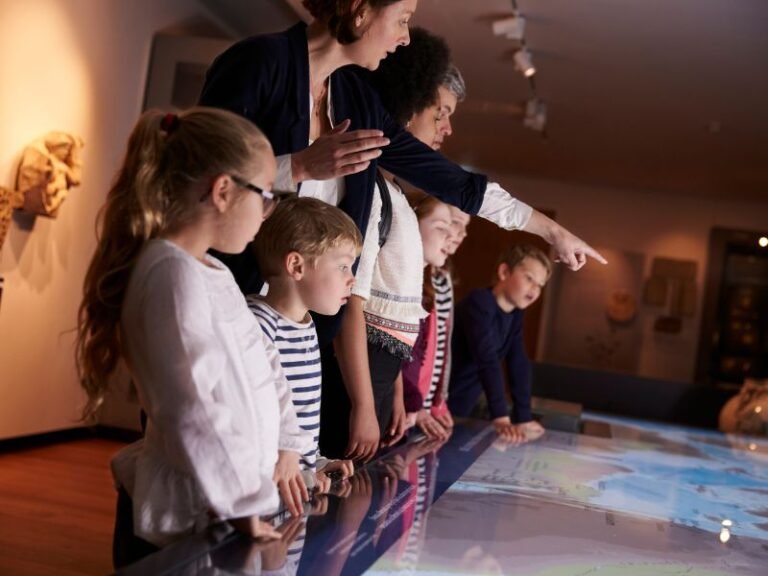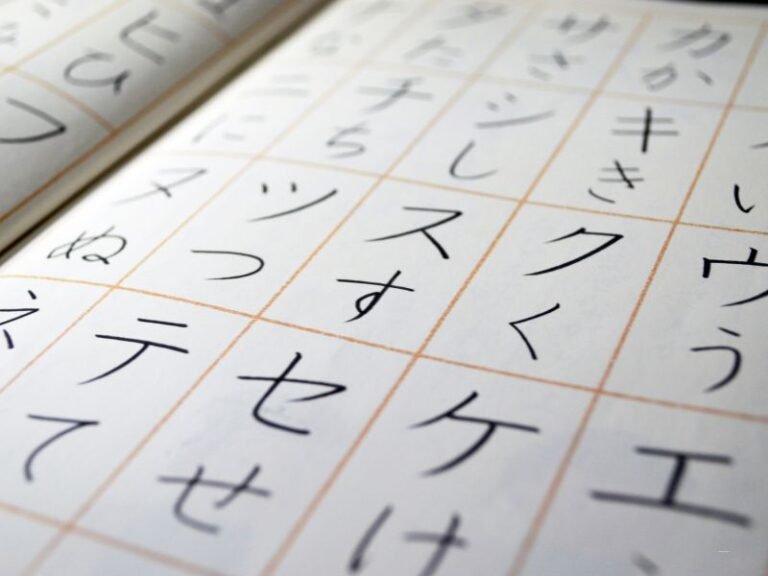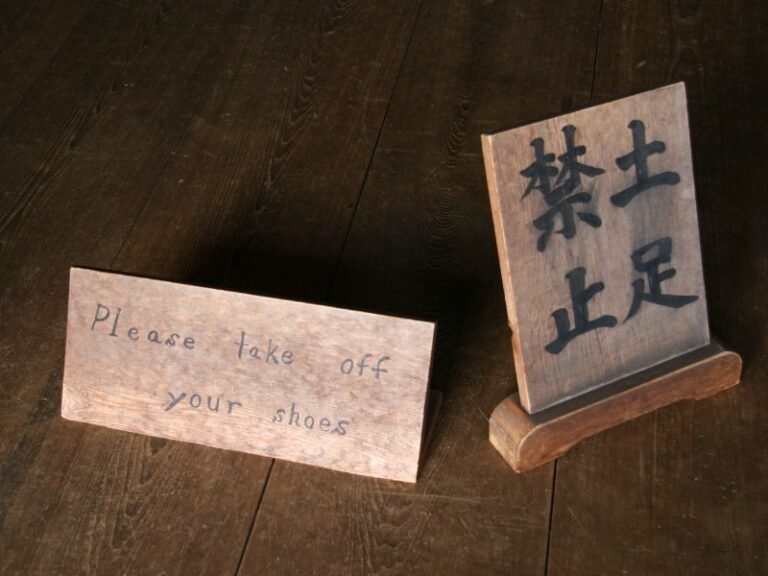The Ultimate Guide to Onsen in Japan (2025) : Culture & Helpful Travel Tips
When I lived in Japan, visiting an onsen was one of my favorite ways to relax and recharge. I went often — sometimes alone, sometimes with friends — and every time felt a little different. While soaking in the warm mineral water, I would quietly reflect on my day, think about what I wanted to do next, or enjoy casual, joyful conversations with friends.
Now that I live in the U.S., I miss those peaceful moments more than I expected. To me, an onsen is not just hot water — it’s a place that comforts the body, clears the mind, and gives you quiet strength for tomorrow.
In this ultimate guide to onsen in Japan post, I want to share with you what onsen truly means in Japanese culture, how to enjoy it properly, and where to find some of the most amazing hot springs in Japan. Whether you’re a first-time visitor or simply curious, I hope this guide helps you fall in love with onsen the way I did.
What is an Onsen in Japan?
An onsen (温泉) is a Japanese hot spring bath that uses geothermally heated water rich in minerals. By official definition, the water must naturally come from underground and contain specific levels of minerals like sulfur, iron, or alkaline elements. These minerals are believed to offer various health benefits — for skin, circulation, muscle recovery, and more.
Onsen (温泉)vs. Sento(銭湯): What’s the Difference?

Many travelers confuse onsen with sento, but they’re not quite the same:
- Onsen (温泉): Uses natural hot spring water. Often located in traditional inns (ryokan), resorts, or scenic regions. The mineral-rich water is the main feature.
- Sento (銭湯): Public bathhouses that use regular tap water, heated for bathing. They were created as a practical solution when many Japanese homes didn’t have baths.
- Super Sento (スーパー銭湯): A modern evolution of sento, these are large-scale bath complexes often found in cities. They offer a variety of baths (sometimes including onsen water), saunas, jacuzzis, and even restaurants, massage rooms, or manga lounges. It’s like a mini spa resort — affordable and casual.
So while all of them offer bathing experiences, only onsen use natural hot spring water as the key attraction.
Types of Onsen Experiences
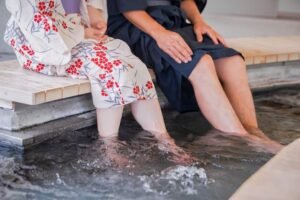
Japan offers a wide range of onsen styles — from luxurious indoor spas to remote riverside springs. Here are some of the most common (and memorable) types you can try:
- Rotenburo (露天風呂) – Outdoor baths are often surrounded by stunning natural scenery like mountains, forests, or snowy landscapes.
- Konyoku (混浴) – Mixed-gender onsen, which are rare today but still exist in some traditional regions.
- Private Onsen (Kazoku-buro (家族風呂) / Kashikiri-buro(貸切風呂) – Great for couples, families, or anyone seeking more privacy. Often found in ryokan or onsen hotels.
- Ashiyu (足湯) – Foot baths that are usually located in public areas of onsen towns. They’re free, relaxing, and easy to try.
- Wild Onsen (自然の温泉) – Natural hot springs located in remote outdoor locations like mountains, forests, or riverbanks. These often require a hike or drive into the countryside and are typically free, with no facilities. Some wild onsen offer a truly raw and peaceful experience — no walls, no tickets, just nature and steam. Just be sure to follow local rules, leave no trace, and bring proper supplies.
Pro Tip: Staying in a traditional ryokan often includes access to a beautiful in-house onsen, either shared or private — a perfect way to experience Japanese hospitality and hot springs together.
Essential Etiquette and Rules at Onsen in Japan
Okay, let’s talk about the part that makes most people nervous – onsen etiquette. Don’t worry, it’s not as complicated as it seems, and most Japanese people are very understanding with foreign visitors.
How to Use an Onsen: Step-by-Step Etiquette Guide
Even though onsen are relaxing, many first-time visitors worry about “doing it wrong.” Don’t worry — once you understand the basic flow, it’s simple! Here’s what to expect and how to enjoy your onsen visit from start to finish:
1.Check In (If You’re Staying Overnight)

- If you’re staying at a ryokan or onsen hotel, you’ll check in at the front desk.
- You’ll be given a room key. When you go into your room, you find a yukata (cotton robe), towels, and sometimes slippers for walking around in your room.
2.Enter the Onsen Area

- Look for signs for the public bath. Usually marked as:
- 男 (otoko) = men’s bath (often blue curtain)
- 女 (onna) = women’s bath (often red or pink curtain)
3.Change in the Locker Room

- Undress completely — no swimsuits are allowed. Other naked people who will mostly ignore you (in a good way!)
- Store your clothes and belongings in a locker or basket.
- Bring only your small towel into the bathing area.
4.Wash Thoroughly Before Entering the Bath
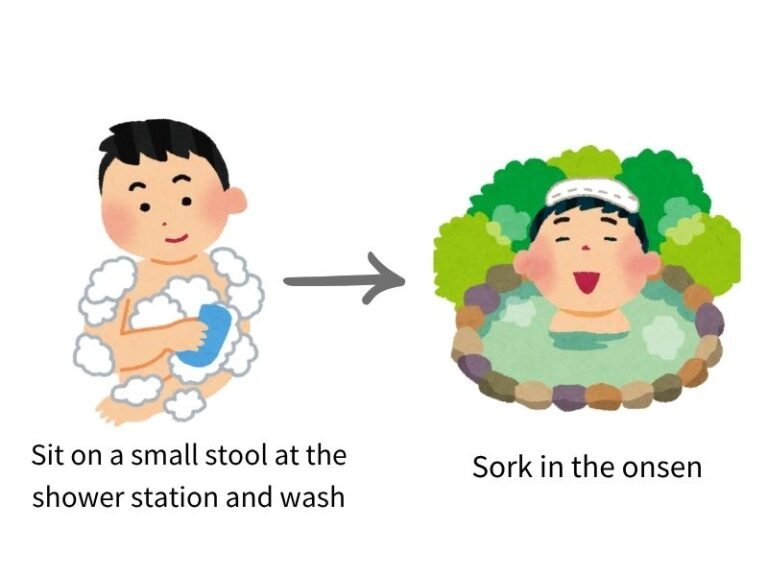
- This is very important! Everyone must wash before soaking.
- Sit on a small stool at a shower station.
- Use the provided shampoo, body wash, and rinse off all soap completely.
- Do not soak before cleaning — it’s considered rude and it makes Japanese people uncomfortable.
- Tie up long hair so it doesn’t touch the water.
5.Enjoy the Onsen Bath

- Enter the bath slowly — it may be very hot!
- Relax and soak, but don’t splash or swim.
- Keep your small towel out of the water (you can place it on your head or beside the tub).
- Speak quietly or enjoy the peaceful silence.
- Limit your soak to 10-15 minutes at a time to avoid overheating (It depends on the temperature)
6.Dry Off Before Returning to the Locker Room
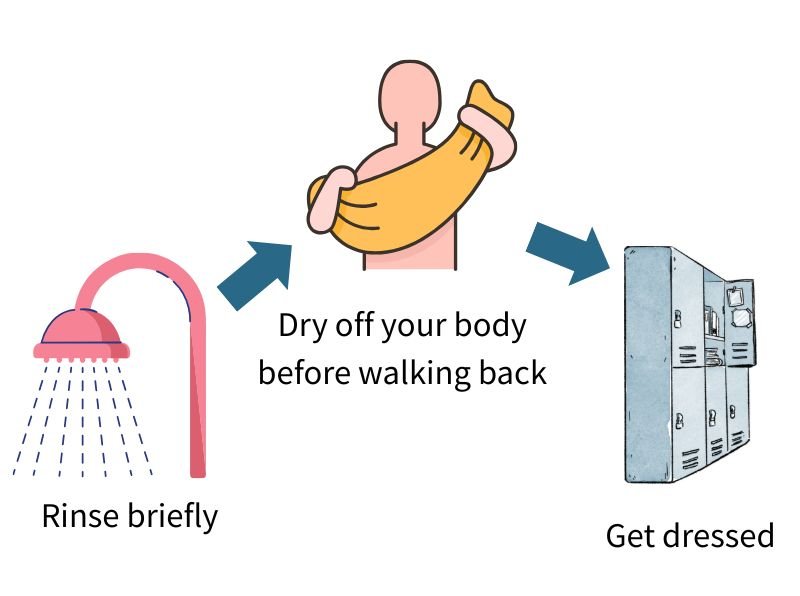
- Use your small towel to dry off your body before walking back.
- Rinse briefly before leaving the bathing area. But do not rinse too much because the Onsen minerals are gone from your skin.
- Keep the floor clean and dry — it’s a courtesy to others.
7. Cool Down & Rehydrate
- After changing, many onsen have relaxation lounges or vending machines.
- Drink water or try a bottle of cold milk / coffee milk — a classic post-onsen treat in Japan!
- Some onsen also offer resting rooms with tatami mats or massage chairs.
8. Optional: Repeat Later
If you’re staying overnight, feel free to enjoy the onsen again later — many people (including me) soak once at night and once in the morning.
Onsen Health Benefits: Why It’s Good for Body and Mind
One of the reasons onsen have been popular for over 1,000 years in Japan is their genuine health benefits. Let me share what science tells us about hot spring bathing.
Physical Health Benefits

Improved circulation
The warm temperature of the water dilates your blood vessels and encourages better blood flow, which can help relieve fatigue and muscle tension.
Relief from muscle & joint pain
Onsen are popular among hikers, athletes, and elderly people in Japan for easing stiff joints, back pain, or chronic aches.
Skin care
Depending on the minerals, onsen can help soften the skin, reduce inflammation, or even help with skin conditions like eczema or acne.
Boosted metabolism and detox
The combination of heat, sweat, and minerals may support mild detoxification and stimulate your body’s natural healing.
Mental & Emotional Benefits

Onsen isn’t just good for the body — it’s also powerful for the mind.
Stress relief
Immersing yourself in warm water while surrounded by nature or quiet spaces is deeply calming. It lowers cortisol (stress hormone) and helps you reset mentally.
Improved sleep
Many people report sleeping better after visiting an onsen. The drop in body temperature after a bath can naturally signal your body it’s time to rest.
Mineral Types & Their Specific Effects
Different onsen have different types of water depending on the local geology. Here are some common ones and their reputed health benefits:
| Mineral Type | Japanese Name | Known Benefits |
|---|---|---|
| Sulfur | 硫黄泉 (iou-sen) | Good for skin problems, circulation, and muscle relief |
| Sodium chloride | 塩化物泉 (enkabutsu-sen) | Helps retain body heat and relieve fatigue |
| Hydrogen carbonate | 炭酸水素塩泉 (tansan-suiso-en-sen) | Softens and beautifies the skin |
| Iron | 含鉄泉 (gantetsu-sen) | Good for anemia and fatigue |
| Carbon dioxide | 二酸化炭素泉 (nisanka-tanso-sen) | Boosts blood circulation and lowers blood pressure |
| Alkaline simple water | 単純泉 (tanjun-sen) | Gentle on the skin and good for relaxation |
Tip: Onsen towns often promote their water type as a key feature — if you’re looking for specific effects (like skin or muscle relief), check the water composition before you go!
Best Onsen Town in Japan
Japan has incredible onsen all over the country. Here are the regions and destinations I always recommend:
Hokkaido (北海道)
Known for snow, volcanoes, and rich natural hot springs.
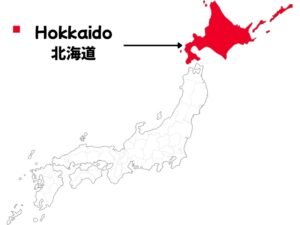
- Noboribetsu Onsen 登別温泉– Famous for its sulfur-rich water and dramatic “Hell Valley” (Jigokudani).
- Jozankei Onsen定山渓温泉 – Located near Sapporo; beautiful fall colors and relaxing riverside baths.
- Yunokawa Onsen 湯の川温泉 (Hakodate) – Seaside onsen with views of the ocean; known for monkey hot springs at the zoo!
Tohoku (東北)
Northern Honshu with mountain onsens and a traditional atmosphere.
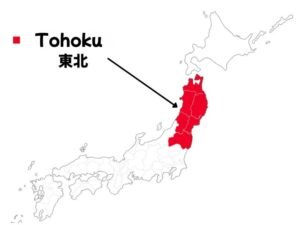
- Nyuto Onsen 乳頭温泉(Akita) – Remote and rustic; milky white water in a forest setting
- Ginzan Onsen 銀山温泉 (Yamagata) – Romantic, old-town charm with gas lamps and riverside ryokan.
- Akiu Onsen 秋保温泉 (Miyagi) – Historic onsen town near Sendai with great nature and waterfalls
Kanto (関東)
Accessible from Tokyo — perfect for day trips and short stays.
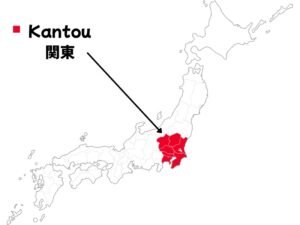
- Hakone Onsen 箱根温泉 (Kanagawa) – Popular and scenic with views of Mt. Fuji, art museums, and private onsen.
- Kusatsu Onsen 草津温泉 (Gunma) – One of Japan’s top three onsen, known for its high acidity and “Yubatake” hot water field.
- Kinugawa Onsen 鬼怒川温泉 (Tochigi) – Family-friendly and near Nikko’s cultural sites and nature.
Chubu (中部)
Home to the Alps, peaceful towns, and legendary hot springs.
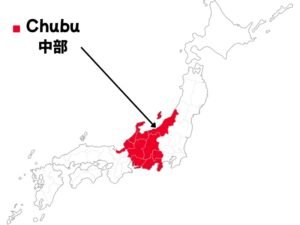
- Gero Onsen 下呂温泉(Gifu) – One of Japan’s three most famous onsen since ancient times.
- Shibu Onsen 渋温泉(Nagano) – Traditional village near the Jigokudani Snow Monkey Park.
- Bessho Onsen 別所温泉 (Nagano) – Quiet and historic with temples and cozy ryokan.
Kinki (近畿)
Mix of city access and rustic beauty; ideal for first-time visitors.

- Arima Onsen 有馬温泉(Hyogo) – Just 30 minutes from Kobe; famous for “gold” and “silver” mineral springs.
- Kinosaki Onsen城崎温泉 (Hyogo) – Wear a yukata and hop between 7 public baths in a charming canal town.
- Yunohana Onsen 湯の花温泉 (Kyoto) – A hidden gem near Kyoto’s countryside.
Chugoku & Shikoku (中国・四国)
Relaxing, often less touristy — perfect for off-the-beaten-path travelers.

- Dogo Onsen 道後温泉 (Ehime) – One of Japan’s oldest and most historic onsen, with a retro bathhouse.
- Yunotsu Onsen 温泉津温泉 (Shimane) – A quiet and historical hot spring town along the coast.
- Iya Valley Onsen 祖谷温泉 (Tokushima) – Surrounded by mountains and bridges, ideal for nature lovers.
Kyushu (九州)

Rich in volcanic activity and known as Japan’s onsen paradise.
- Beppu Onsen 別府温泉 (Oita) – Famous for steam, mud baths, and “hell” viewing spots. Huge variety of bath types.
- Kurokawa Onsen 黒川温泉 (Kumamoto) – Traditional wooden ryokan and scenic mountain setting.
- Unzen Onsen 雲仙温泉 (Nagasaki) – Atmospheric and misty, with sulfuric vents in a national park.
Need to check the Japanese local food? Visit my Japanese food guide from the button below!
Ryokan Stay vs. Day-Use Onsen: Which Should You Choose?

If you’re planning to visit an onsen in Japan, one of the first decisions is:Should I stay overnight at a ryokan or just go for a day-use onsen visit?
Both options offer amazing experiences — it depends on your schedule, budget, and travel style. Let’s compare them:
Staying at a Ryokan with Onsen
A ryokan (旅館) is a traditional Japanese inn, and many of them include onsen baths — often reserved for guests.
✅ Pros:
Access to private or exclusive guest-only onsen baths
- Enjoy a full Japanese kaiseki dinner and breakfast included
- Wear a yukata robe and feel immersed in Japanese culture
- More relaxing: no time limits, perfect for unwinding after sightseeing
- Many have in-room or family-style private baths
❌ Cons:
Higher cost (usually ¥15,000–¥30,000+ per person with meals)
- Must book in advance, especially in popular towns
- Limited flexibility for travelers on tight itineraries
Using a Day-Use Onsen (日帰り入浴 Higaeri Nyuyoku)
Many onsen towns offer day-use options where you can soak in the hot springs for a few hours without staying overnight.
✅ Pros:
- Affordable (typically ¥500–¥1500 per visit)
- No reservation needed for most places
- Great for day trips or flexible travelers
- Try multiple onsen in one town (like in Beppu or Kinosaki)
❌ Cons:
- Limited access to private or premium baths
- Shorter, less immersive experience
- You’ll need to bring or rent(buy) towels
💡 Which Do I Recommend?
First-time onsen traveler? Try a ryokan stay at least once — it’s the best way to fully experience Japanese hospitality and culture. The dinner or breakfast would be a Japanese traditional meal. I love it because I am Japanese, but you may not like it, I believe the experience is to be your amazing travel memory.
On a tight budget or schedule? Day-use onsen is a perfect, flexible choice (and you can visit more than one!). Please make sure if the ryokan has the day-use option before you go.
Frequently Asked Questions
Let me address the most common questions I get about onsen experiences:
Lorem ipsum dolor sit amet, consectetur adipiscing elit. Ut elit tellus, luctus nec ullamcorper mattis, pulvinar dapibus leo.
General Questions
Q: Do I need to speak Japanese to enjoy onsen?
A: Not at all! While knowing basic terms helps, many onsen in tourist areas have English signs and staff. The bathing process is intuitive once you understand the basic steps. I’ve seen plenty of visitors who spoke no Japanese have wonderful onsen experiences.
Q: How long should I stay in an onsen?
A: Start with 10-15 minutes per session. You can always get out, cool down, and go back in. Most people do 2-3 soaking sessions during a visit. Listen to your body – if you feel dizzy or overheated, get out immediately.
Q: Can I visit multiple onsen in one day?
A: Absolutely! This is called “onsen hopping” and it’s quite popular. Just be mindful not to overdo it – too much hot water bathing can be exhausting and feel bad.
Q: What if I have medical conditions?
A: Consult your doctor first, especially for heart conditions, high blood pressure, or pregnancy. Many onsen have signs listing medical conditions that should avoid bathing. When in doubt, ask staff or skip the onsen.
Etiquette Concerns
Q: What happens if I make a mistake?
A: Don’t panic! Most Japanese people understand that foreign visitors are learning. A polite bow and “sumimasen” (excuse me) goes a long way. I’ve never seen anyone get angry at a genuine mistake from a respectful visitor.
Q: Can I bring my own towel and soap?
A: Yes! Many experienced onsen visitors bring their own towels and preferred toiletries. Just make sure your towel doesn’t go in the water – keep it folded on your head or beside the bath. In the onsen area, you may find a small storage place of your toiletries.
Q: Is it okay to talk to other bathers?
A: Light, quiet conversation is generally okay, but onsen are primarily for relaxation and peace. Avoid loud talking, splashing, or anything that disturbs the quiet atmosphere. When in doubt, stay quiet and just enjoy the experience.
Q: What if I’m embarrassed about being naked?
A: This is completely normal! Remember that everyone is in the same situation, and most people are focused on their own relaxation. The cultural context makes it less awkward than you might expect. Start with less crowded times or consider private onsen if you’re very concerned.
Practical Questions
Q: How much does onsen cost?
A: Day visits: ¥400-1,500 per person Ryokan stays: ¥8,000-50,000+ per person (including meals) Private onsen rental: ¥2,000-8,000 per hour Towel rental: ¥200-500 if needed.
Q: Can I get a refund if I can’t enter due to tattoos?
A: Policies vary by establishment. Some places are understanding and will refund your fee, others are strict about their no-refund policy. Always ask about tattoo policies before paying, or call ahead to confirm.
Q: Do I need reservations for day visits?
A: Most day-trip onsen accept walk-ins, but popular places might have waiting times during peak hours. Private onsen always require reservations. For peace of mind, especially during busy seasons, calling ahead is recommended.
Q: What’s the difference between expensive and cheap onsen?
A: Expensive onsen usually offer: better facilities, premium locations, higher quality amenities, gourmet meals (at ryokan), more variety of baths, luxury services. Budget onsen provide: basic but clean facilities, simpler amenities, local atmosphere, great value for the core onsen experience.
Both can be wonderful – it depends on what you’re looking for!
Related: Japanese Etiquette Basics for Travelers
Before visiting an onsen, it’s helpful to understand the general rules of Japanese manners—especially how to behave in public and shared spaces
👉 Read next: Essential Japanese Etiquette Tips Every Traveler Should Know
This guide covers things like bowing, public transport behavior, and small cultural gestures that can help you feel more confident and respectful during your trip.
Final Thoughts
Congratulations! You now know everything you need to confidently enjoy one of Japan’s most treasured cultural experiences.
From understanding the difference between onsen and sento to navigating etiquette and choosing the perfect destination, you’re ready to dive into the wonderful world of Japanese hot springs.
Safe travels, and enjoy your onsen adventure!
Have you visited an onsen in Japan? Share your experience in the comments below! Planning your first visit? Let me know if you have any questions – I love helping people discover the magic of Japanese hot springs.

